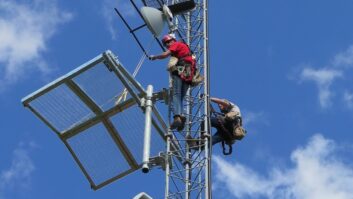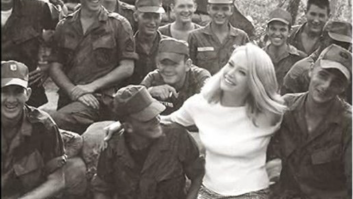We Check In With KQED and Its Investment in 29 MDP500 PortaDisc Machines
The Hewlett-Packard press conference was running late, precariously close to the deadline to tease the noon news on ABC Radio station KGO(AM) in San Francisco. Veteran reporter Lee Schell of KGO was visibly anxious as he glanced at an empty podium, then back to his wristwatch and cell phone.
“Tight, tight, too tight,” was his oft-repeated mantra.
This made-for-media event, starring embattled Hewlett-Packard CEO Carly Fiorina, was a typical electronic newsgathering affair. There was none of that “whir of cameras, popping of flashbulbs” hype about newspaper journalists wax poetically. Digital ENG is sophisticated and elegantly quiet, with only an occasional conspicuous cough to add atmosphere.
Schell and the usual suspects – radio colleagues from KCBS, Reuters and the BBC – all converged on a multbox below the podium, furiously jabbing their 1/8-inch mini-to-XLR plugs into the forest of receptacles.
Unlike their video and still colleagues, operating digital capture devices priced in the four-to-five figure range, these radio pros were each equipped with consumer-model MiniDisc recorders, with max MSRPs of $400, most costing much, much less.
“$400 for a recorder? Man, that is my audio budget for the year,” scoffed one AM radio reporter.
When the KQED reporter showed up with a stunning purple HHB MDP500 ($1,599) and XLR’d into the multbox, there was a chorus of “ohhhhs.”
“Man, I wish the suits would pop for one of those,” lamented the AM guy, “it sure would make my job easier.”
What happened to radio news recording? Why have so few serious professional players – HHB among them – emerged to capture a niche that was once owned by the ubiquitous, rock-solid 200-series cassette units from Marantz?
Tiny budgets
The answer is simple: when news budgets talk, the talk gets cheap. Consumer MiniDisc rules news because it is both good and inexpensive. Reliability, however, is another issue.
For instance, KGO’s Schell reluctantly went back to a cassette recorder out of fear and frustration when his Sony MiniDisc recorder too often erroneously erased entire files.
Is the future of radio ENG sitting on the shelf of the local Best Buy or Circuit City? Maybe not.
I decided to track the market impact of the HHB MDP500 PortaDisc by following up on the evaluation by Carl Lindemann of the then-new MiniDisc recorder (RW, May 23, 2001).
Lindemann enthusiastically pronounced the HHB unit “definitely on the mark … with extensive XLR, multiple digital I/O options plus USB; phantom power; even a 1/4-inch headphone jack … all show(ing) a deep appreciation for what is needed for fieldwork. The PortaDisc should quickly become the pro MiniDisc of choice as the PortaDAT was when DAT ruled.”
I followed the ENG money trail to KQED, the San Francisco NPR affiliate, where Chief Engineer Dan Mansergh persuaded management a year ago to purchase 25 (later upped to 29) MDP500s, a stunning investment that has paid dividends. Michael Johnson, the KQED digital training manager, maintains the fleet and sustains the MiniDisc Web site.
Standardizing pays off
The bottom line? Bite the bullet and standardize on one recorder.
“We were in the process of going through a digital conversion,” said Mansergh. “We needed a recorder with the ruggedness and professional features comparable to the Sony TCD-5M (cassette recorder).”
A simple enough goal, although he faced major decision challenges.
The KQED news staff had partially self-transitioned into a mixed bag of Sony and Sharp consumer MiniDisc units, feeding their desire for a physically tangible and inexpensive recording media that could be archived easily, like cassettes.
Mansergh originally was drawn to flash-card recorders, like the Marantz 680/690. The Marantz offered serious, adult I/Os including the all-important XLR connectivity along with the ability to off-load audio files into a laptop with drag-and-drop ease. Media costs, however, especially for long interviews plus archiving issues, concerned him.
“The big disadvantage with the IC card recorders is that the media cost does not justify going out and buying a lot of them,” said Mansergh. “A key factor in looking at new equipment (for reporters) was having a physical media that was inexpensive. Besides, MiniDisc is digital, quiet, has a fairly mild compression scheme and is consistent with our internal editing format.”
Besides, the staff liked the “cool” HHB purple color, individual user presets, the built-in speaker, the large controls and display – and the six-second buffer, especially useful for dull news conferences where the reporter might be a little slow to push the record button.
Mansergh needed one standard recorder to support and service in-house instead of the variety of models the station was accumulating haphazardly. He bit the bullet and made the buying decision for the HHB.
“We attracted a lot of attention early on with the HHB units, especially at press conferences,” he said.
Is the HHB unit perfect in every way?
“The audio quality is great, the usability of the interface is intuitive and deep; however, the HHB estimates of battery life were optimistic,” he said. He generously suggests that the recording mechanism may not be optimized for low-power consumption, although he concedes that he expected that going in.
Mersergh instructs reporters using the HHB’s lighted display to do so carefully, conserving battery life for mission-critical applications. This sort of knowledge, based on the station reporters’ experience with the HHB units, is available to staff on a proprietary portion of the KQED internal Web site. It is packed with MiniDisc FAQs and user service tips.
Can take a licking
How do the 29 HHB units handle the rigors of the news business? Acoording to an old newsroom cliché, “You can make audio recorders foolproof; however, you cannot make them reporter-proof.”
The HHB units have been literally banged around during their year on the job despite Mersergh’s admonishments to the staff to keep the unit in a bag.
“The shock mount on the (recording) mechanism is good but it is not really meant to be dropped onto a concrete floor,” Mersergh said. “We have had bent metal and cracked plastic. Some have survived just fine. You know, it is not an all-metal case, like the Sony TCD-5M, but it is pretty solid.”
One MDP500 swallowed an errant nickel coin floating around in the reporter’s bag. Michael Johnson, KQED digital training manager and resident MiniDisc expert, disassembled the unit as the talent shrugged, “Gee, it worked just fine a few minutes ago.”
The problem? The coin had lodged in the MiniDisc slot. Johnson’s needlenose surgery relieved the reporter’s pain.
Johnson is an experienced MiniDisc user (four years) and is tasked with keeping the station’s MD investment up. He likes the MDP500, at times sounding like the Timex “Takes a lickin’ and keeps on tickin'” slogan.
“It can take a hit and keep working. The mechanism is sturdy, strong and stable,” said Johnson. “When I first opened it up, I thought, ‘Okay, this has a lot of heft to it.’ It will be an adjustment for the staff from the shirt-pocket size units.”
Practicality, user friendliness and serviceability are Johnson’s main criteria for success.
“One neat feature is that the table of contents (TOC) is held in memory. If your batteries die during a recording or the machine freezes up and has to be rebooted, the TOC is rewritten,” Johnson said.
“When KQED does something, they do it big and they do it serious,” Johnson said. “We wanted a professional-grade machine, the MiniDisc equivalent of the Sony TCD-5M, something that was going to be rugged and dependable out in the field and interface with our new digital systems that are coming online.”
Both Johnson and Mersergh have short wish lists for the HHB: better battery life and drag-and-drop capability through the USB port beyond the current 1X real-time transfer speed. This is more of a limitation of the MiniDisc medium, unlike a flash card or a hard drive.
Mersergh’s eyes glaze over when he talks about the future of ENG audio recording. His vision? An Apple IPOD-like device bristling with XLR plugs; a reverse synchronization system; low power consumption plus a lithium polymer battery; buffering audio into memory; FireWire; a 20 GB hard drive …
Wait a minute, Dan, what about the all-important archiving issue so dear to the hearts of reporters – and you?
You just know he’ll work that one out.
You’ll find more MiniDisc information from Michael Johnson of KQED at http://1stperson.org/story.php?s=100 and http://1stperson.org/discuss.php?s=100
For information from HHB, visit www.hhbusa.com. A MiniDisc user retail site can be found at www.MiniDisco.com.











